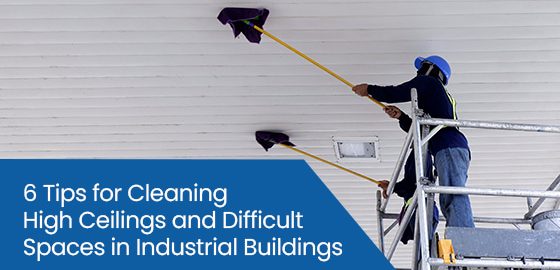6 Tips for Cleaning High Ceilings and Difficult Spaces in Industrial Buildings

Cleaning high ceilings in industrial facilities presents unique challenges that demand more than just standard janitorial tools. These elevated zones can accumulate layers of dust, grime, and harmful substances; elements that, if left unchecked, impact air quality, equipment performance, and employee safety.
Maintaining these spaces goes beyond basic cleanliness. It's a matter of minimizing risk and supporting operational efficiency. With the right tools, procedures, and safety measures in place, facility managers can approach overhead cleaning with confidence, precision, and consistency.
The following six tips offer practical guidance for safely and effectively managing high-ceiling cleaning tasks in industrial settings.
1. Assess and prepare the area
Begin with a thorough walk-through of the space. Identify potential hazards, such as loose panels, exposed wires, or fragile equipment, that could interfere with cleaning or compromise safety. Take note of the types of buildup you’re dealing with, whether dust, grease, or chemical residue, so you can choose the right cleaning method.
Once the risks are assessed, protect the space below. Cover or relocate equipment, tools, and materials as needed. Mark off the area using signage or physical barriers to control traffic and prevent accidental entry during the cleaning process. A well-prepared space sets the stage for safe, efficient work.
2. Use the right access equipment
Accessing overhead spaces safely demands the right equipment and knowing when and how to use it. Depending on your building’s structure and ceiling height, you may need different tools for different zones:
- Scissor lifts or boom lifts offer stable, elevated access to high or awkward vertical surfaces.
- Mobile scaffolding systems are useful for extended reach in confined areas or where lifts can't operate safely.
- Telescopic poles and lightweight extension tools allow for quick, ground-level cleaning of moderately high surfaces.
All equipment must be industrial-grade, properly maintained, and compliant with safety standards. It’s not just about having access; operators need to be trained and certified to ensure safe, controlled movement throughout the cleaning process. The right setup makes the difference between a job done safely and a project riddled with unnecessary risk.
3. Apply strict fall protection practices
Any task that involves working at height demands proper fall protection. This includes the use of full-body harnesses, lanyards, certified anchor points, and a clear understanding of how to use them.
Fall hazards are among the most serious risks in industrial environments. Even quick tasks can result in injury if proper safety measures aren’t followed. Ensuring everyone on your team is trained and equipped reduces the risk of accidents and supports a safety-first culture.
4. Choose effective cleaning techniques
The right method depends on the materials and types of debris involved. Ceilings often conceal HVAC ductwork, electrical systems, lighting fixtures, and support beams. These areas tend to collect everything from fine dust to sticky residue and chemical deposits.
To remove dust, use HEPA-filter vacuums or extendable microfiber tools designed to trap particles instead of dispersing them.
For grease and grime, opt for non-abrasive cleaning agents and soft cloths that clean thoroughly without damaging surfaces. Always clean from the top down to avoid recontamination.
Water-based cleaning methods should be used cautiously. High-pressure washers can damage electrical components, introduce moisture into sensitive areas, and increase slip hazards. If water is required, use containment, ventilation, and drying systems to manage the risks.
5. Manage air quality during cleaning
High-level cleaning can disturb fine dust and airborne contaminants. To protect indoor air quality and your team’s respiratory health, plan for:
- Portable air scrubbers that remove particles as they become airborne
- Ventilation equipment that controls airflow and keeps contaminants contained
- Respiratory protection, such as N95 masks or half-face respirators, where needed
Good air quality management should begin before cleaning starts and continue until the job is complete. Build it into your cleaning plan as a core safety measure.
6. Schedule preventive cleaning cycles
Waiting until dust and grime are visible means you're already behind. Regular cleaning reduces buildup, protects your assets, and ensures a safer workspace.
Schedule high-level cleaning during planned downtime or periods of low activity. This minimizes disruption and allows for safer, more focused work. Keep detailed records of each cleaning session, including dates, teams involved, methods used, and areas covered. This helps support audits, improve scheduling, and track maintenance needs over time.
Preventive maintenance pays off; it keeps your space compliant, your equipment running longer, and your team working in a healthier environment.
RBC Clean: Expert Ceiling Cleaning Services for Industrial Buildings
Ceiling cleaning is an essential part of maintaining a clean, safe, and efficient facility. When you work with a professional partner like RBC Clean, you get a team that understands the technical demands of high-level cleaning and prioritizes safety every step of the way.
Our crews are fully trained in fall protection, contaminant control, and working around sensitive machinery. We tailor our approach to the specifics of your site, whether that means accessing tight overhead spaces or scheduling work around your production cycle.
RBC Clean delivers high-level cleaning services using certified aerial access equipment and established safety protocols. To find out how we can support your facility, call us at 1-866-278-8208 or contact us here. Based in Aurora, we proudly serve industrial and commercial facilities across Southern Ontario and the GTA.



